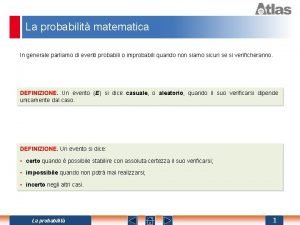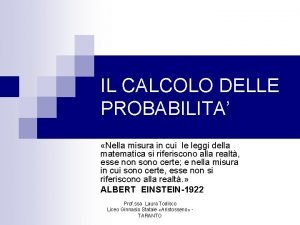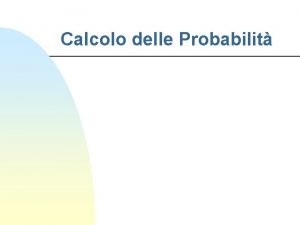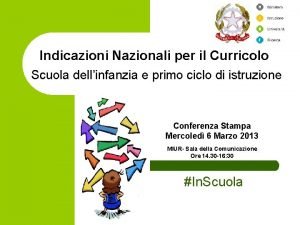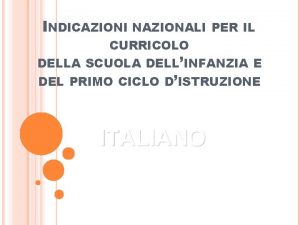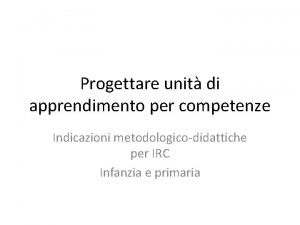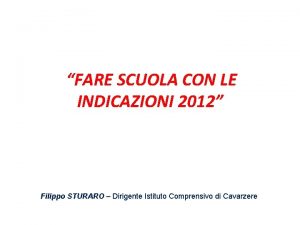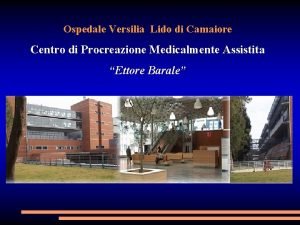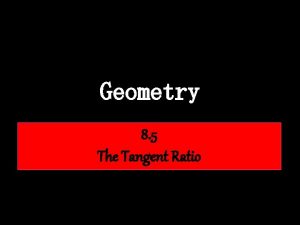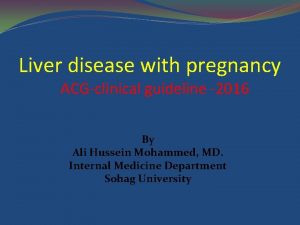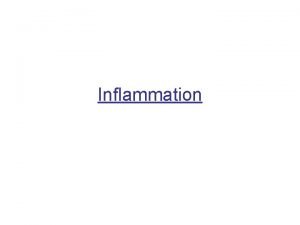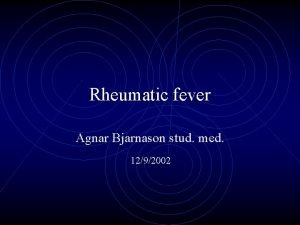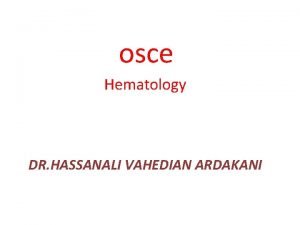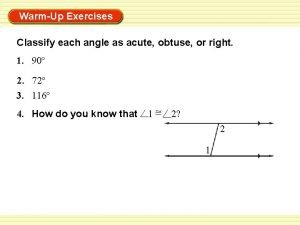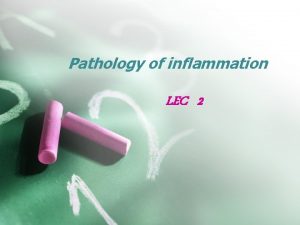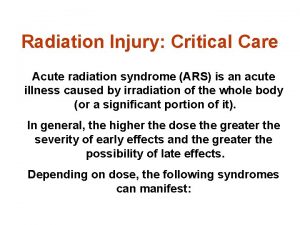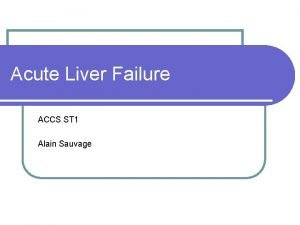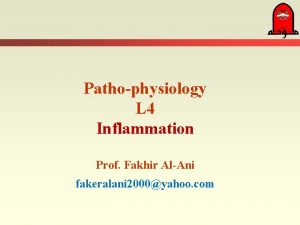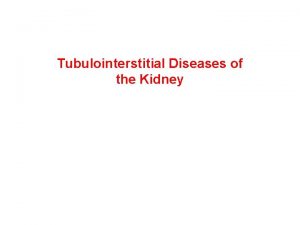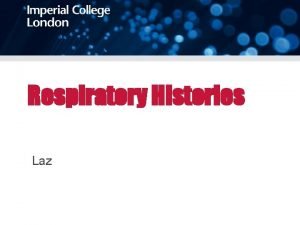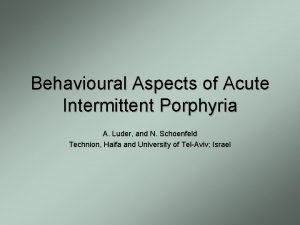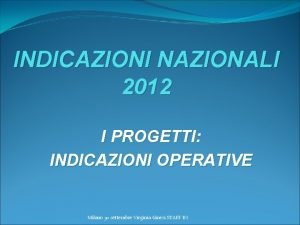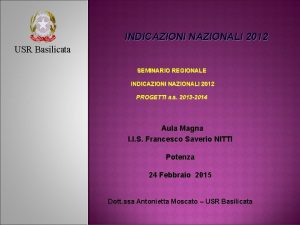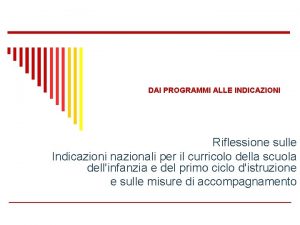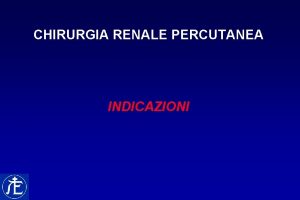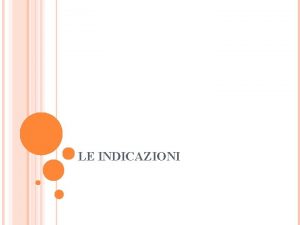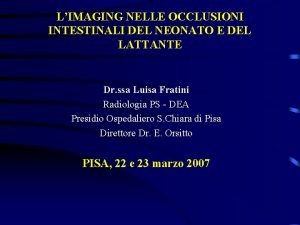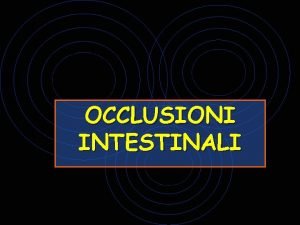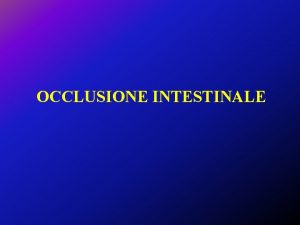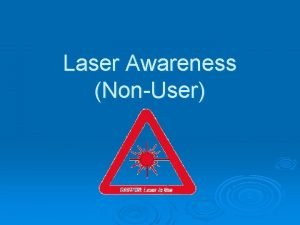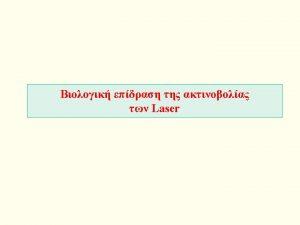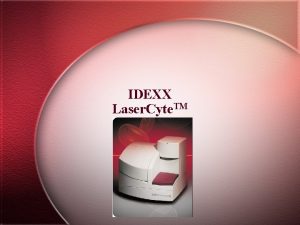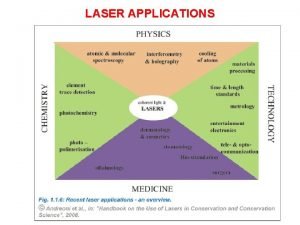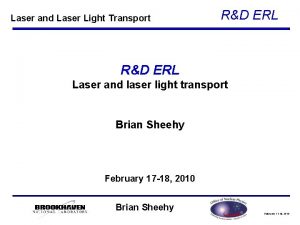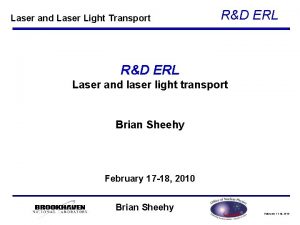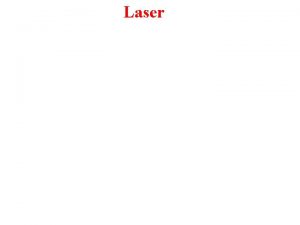INDICAZIONI DELLANGIOPLASTICA LASER ASSISTITA CORONARICA Occlusioni totali acute
































- Slides: 32

INDICAZIONI DELL’ANGIOPLASTICA LASER ASSISTITA CORONARICA Occlusioni totali acute e croniche (CTO) Occlusioni di Graft Venosi (by-pass) Lesioni calcifiche Lesioni resistenti alla dilatazione (Balloon failure) Stent Inespansi (Stent dilatation failure) Ristenosi intra-stent Lesioni ostiali Lesioni lunghe Infarto Miocardico Acuto (IMA) per la vaporizzazione del trombo

LASER NEL TRATTAMENTO DELL’INFARTO MIOCARDICO ACUTO (IMA)

Laser ed IMA 2008

Laser ed IMA - Results 2008 66 Patients End-points Results

ELT-AMI Study 2018 A randomized blind comparison of Excimer Laser vs courrent Thrombus treatment for the prevention of no-reflow during primary percutaneous coronary intervention of st-elevation myocardial infarction Prof. Versaci (Latina) P. I. Dr. Ambrosini (Avellino) Prof. Colombo (Milano) Prof. Balbi (Genova) Dr. Bernardi (Udine) Dr. Gabrielli (Ancona) Dr. Moretti (Ascoli Piceno) co-P. I. Dr. Contarini (Siracusa) Dr. Chizzola (Brescia) ELT- AMI is a randomized, open-label, active controlled, multinational investigator- initiated clinical trial. Patients undergoing PPCI will be randomly assigned to 1 of 2 interventional strategies of reperfusion: MTA-assisted PPCI alone or EL-assisted PPCI alone. Nine Italian high volume centers will be involved in the study.

LASER NEL TRATTAMENTO DEGLI STENT SOTTO-ESPANSI

Unexpanded Stent: Articles 2013

ELLEMENT: Pilot Study Excimer Laser LEsion Modification to Expand Nondilatable s. Tents 2014 Antonio COLOMBO (Milano) Investigatore Principale • Vittorio AMBROSINI (Mercogliano) • Giampaolo NICCOLI (Roma) • Marco Valgimigli (Ferrara) • Giuliano Chizzola (Brescia) • Pasquale Lisanti (Potenza) • Corrado Tamburino (Catania) Objective: To assess if the adjunctive use of ELCA lesion modification can improve minimal stent cross-sectional area on IVUS in under-expanded stents

ELLEMENT: Articles 2014

ELLEMENT: RESULTS

CLINICAL CASE 1

CLINICAL CASE 1 (A) (B) (D) (C) (E)

Clinical Case 2 Laser 0. 9 mm Complete expansion Final Result

EXPAND-CLI Study Excimer laser atherectomy for management of unexpanded second generation drug-eluting stent in calcific coronary lesions (the EXPAND-CLI Trial) Prospective, multi-centre, study assessing the impact of excimer laser atherectomy for the treatment of unexpanded stent during angioplasty of calcified complex coronary lesions. Primary End-Point: Improvement of stent expansion at OCT (comparison between in stent MSA and mean reference lumen area 2018 Francesco Prati (Roma) P. I. Dr. Ambrosini (Avellino) Dr. (Milano) Dr. Versaci (Latina) Dr. Gabrielli (Ancona) Dr. Bernardi (Pordenone) Dr. Moretti (Ascoli Piceno) Dr. Chizzola (Brescia) Statistical Analysis Dr. ssa Laura Gatto, Dr. Enrico Romagnoli (Azienda Ospedaliera San Giovanni Addolorata Roma)

PROTOCOL SUMMARY Design Prospective, multi-centre, study assessing the impact of excimer laser atherectomy for the treatment of unexpanded stent during angioplasty of calcified complex coronary lesions. Study Population Consecutive patients presenting calcific lesions at diagnostic angiography candidates for percutaneous coronary intervention. Time Course Initial Enrolment: March 2018 End of the Enrolment: June 2019 (or 40 enrolled patients) Primary End-Point Improvement of stent expansion at OCT (comparison between in stent MSA and mean reference lumen area) Secondary End-Points Thirty-day myocardial infarction (MI, including peri-procedural MI) Thirty-day net adverse clinical events (MACE) defined as the composite of cardiac-cause death, MI, target vessel revascularization, definite-probable stent thrombosis. Assessment of the effects of laser excimer atherectomy on the stent/vessel binomial in presence of calcific atherosclerosis: in particular, potential stent deformation/fracture, asymmetrical struts distribution and expansion will be considered.

Leonardo 2015 Cardiovasc Revasc Med. 2015 Feb 11. Early outcome of high energy laser (excimer) facilitated coronary angioplasty on hard and complex calcified and balloon-resistant coronary lesions: LEONARDO STUDY Ambrosini V 1, Sorropago G 1, Laurenzano E 1, Golino L 2, Casafina A 1, Schiano V 1, Gabrielli G 3, Ettori F 4, Chizzola G 4, Bernardi G 5, Spedicato L 5, Armigliato P 6, Spampanato C 7, Furegato M 6. 1 Montevergine Clinic, Mercogliano, Italy. 2 Montevergine Clinic, Mercogliano, Italy; Moriggia-Pelascini Hospital, Gravedona, Como, Italy. Electronic address: lucagolino. jazz@alice. it. 3 University Hospital Ospedali Riuniti, Ancona, Italy. 4 Spedali Civili University Hospital, Brescia, Italy. 5 University Hospital S. Maria Misericordia, Udine, Italy. 6 Istituto Italiano Ricerche Mediche, Verona, Italy. 7 Telethon Institute of Genetics and Medicine (TIGEM), Naples, Italy.

Leonardo: Results AIM: An innovative xenon-chlorine (excimer) pulsed laser catheter (ELCA X 80) has been recently used for the treatment of complex coronary lesions, as calcified stenosis, chronic total occlusions and non-compliant plaques. Such complex lesions are difficult to adequately treat with balloon angioplasty and/or intracoronary stenting. The aim of this study was to examine the acute outcome of this approach on a cohort of patients with coronary lesions. METHODS AND RESULTS: Eighty patients with 100 lesions were enrolled through four centers, and excimer laser coronary angioplasty was performed on 96 lesions (96%). Safety and effectiveness data were compared between patients treated with standard laser therapy and those treated with increased laser therapy. Laser success was obtained in 90 lesions (93. 7%), procedural success was reached in 88 lesions (91. 7%), and clinical success in was obtained in 87 lesions (90. 6%). There was no perforation, major side branch occlusion, spasm, no-reflow phenomenon, dissection nor acute vessel closure. Increased laser parameters were used successfully for 49 resistant lesions without complications.

Leonardo: Conclusion This study suggests that laser-facilitated coronary angioplasty is a simple, safe and effective device for the management of complex coronary lesions. Furthermore, higher laser energy levels delivered by this catheter improved the device performance without increasing complications.

The use of excimer laser for complex coronary artery lesions (2015) Ben-Dor I, Maluenda G, Pichard AD, Satler LF, Gallino R, Lindsay J, Waksman R. • Abstract • Excimer laser coronary atherectomy (ELCA) has been used for coronary intervention for more than 20 years. Advances in delivery systems for laser energy using the xenon-chlorine pulsed laser catheter deliver higher energy density with lower heat production. The Spectranetics CVX-300 (Spectranetics, Colorado Springs, CO, USA) excimer laser catheter system has been used for the treatment of complex coronary lesions. We report our experience with the use of this advanced system for stenoses for which were unsuitable for standard percutaneous coronary intervention; for example, balloon-resistant lesions, chronic total occlusions, and for underexpanded stents in calcified lesions. ELCA may also be valuable for thrombus-containing lesion. We find ELCA to be indispensable in the catheterization laboratory for specific complex or calcified lesions. Its role should be explored in a large randomized trial of thrombus containing lesions and saphenous vein grafts.

LASER NEL TRATTAMENTO DELLA RESTENOSI INTRASTENT

The state of the excimer laser for coronary intervention in the drug-eluting stent era (2011) Badr S 1, Ben-Dor I, Dvir D, Barbash IM, Kitabata H, Minha S, Pendyala LK, Loh JP, Torguson R, Pichard AD, Waksman R. Interventional Cardiology Unit Medstar Hospital Center Washington OBJECTIVES: This study aims to determine how excimer laser coronary atherectomy (ELCA) performs in the drug-eluting stent (DES) era. BACKGROUND: For more than 20 years, ELCA has been used for coronary intervention. With developments in the coronary intervention field, the role of ELCA is in question. METHODS: The study includes 119 patients with 124 lesions who underwent percutaneous coronary intervention (PCI) with ELCA in our institution from January 2004 to May 2011.

The state of the excimer laser for coronary intervention in the drug-eluting stent era (2011) Badr S 1, Ben-Dor I, Dvir D, Barbash IM, Kitabata H, Minha S, Pendyala LK, Loh JP, Torguson R, Pichard AD, Waksman R. Interventional Cardiology Unit Medstar Hospital Center Washington • RESULTS: • The main indications for ELCA use were saphenous vein graft (SVG) (45 lesions), acute myocardial infarction (AMI) (7 lesions), chronic total occlusion (CTO) (32 lesions), in-stent restenosis (ISR) (15 lesions), and calcified de-novo lesions (25 lesions). High success rates were recorded for the SVG, AMI, CTO, ISR, and calcified lesion indications (91. 1%, 85. 7%, 93. 8%, 86. 7%, and 80%; respectively). ELCA related complications were reported in 10 patients (8%); four dissections, three no-reflow phenomena, two perforations, and one thrombus formation. • CONCLUSION: • ELCA is an alternative solution with acceptable performance in the treatment of complex coronary lesions not ideally suitable for balloon angioplasty.

Derist 2016 Cardiovasc Revasc Med. 2016 Feb 11.

LASER NEL PRE-TRATTAMENTO DELLA PLACCA PER L’IMPIANTO DI STENT BIOASSORBIBILI

RAFFAELLO Pilot Study 2017 Objective The objective of this Pilot Study is to suggest that Laser Angioplasty may yield better lesion preparation leading to a larger final lumen following stent implantation. These findings will be particularly relevant when applied to bioresorbable scaffold implants. Laser for complex lesion preparation Non-compliant balloons, Angiosculpt balloon, Cutting balloon and Rotational Atherectomy are the currently available devices to ensure optimal lesion preparation. None of them with the exclusion of Rotational Atherectomy that requires a dedicated wire, have demonstrated predictable effectiveness in complex fibrocalcific lesions. Laser angioplasty with the current advanced devices has the potential to fill this gap. Inclusion criteria: Long lesions requiring stents 38 mm or longer No extreme calcifications requiring, according to the judgment of the investigator, rotational atherectomy Estimated vessel size 2. 5 mm or larger Possibility to perform optical coherence (OCT) study prior to the procedure

RAFFAELLO Pilot Study 2017 Procedure: A baseline OCT exam will be performed Laser angioplasty with Spectranetics Turbo-Elite 0. 9 cath. 80/80 will be performed with a minimum of 2 passes with saline flush Repeat OCT High-pressure balloon dilatation Stent or BRS implantation Postdilatation as needed Repeat final OCT The endpoint of this study will be minimal instent luminal cross sectional area. This value will be compared with matched cases performed with standard technique. We propose performing 10 Pilot cases. This study will be performed in San Raffaele by two dedicated operators dr. Antonio Colombo and dr. Azeem Latib.

ILARY Registry 782 pazienti 33 Centri Partecipanti Prof. Manrico Balbi, Università di Genova - Responsabile Nazionale Registro • Ospedale S. Raffaele (Milano) • Centro Cuore Columbus (Milano) • Centro Cardiologico Monzino (Milano) • Polianbulanza (Brescia) • Spedali Civili (Brescia) • Ospedale Dell’Angelo (Mestre) • Ospedale S. M. degli Angeli (Pordenone) • Ospedale S. M. Misericordia (Udine) • Ospedale S. Martino (Genova) • Ospedale S. Anna (Ferrara) • Clinica Cellini (Torino) • Ospedale Careggi (Firenze) • Ospedali Riuniti (Ancona) • Ospedale Civile (Ascoli) • Policlinico Umberto I° (Roma) • Policlinico Gemelli (Roma) • Ospedale S. M. Goretti (Latina) • Ospedale S. Giovanni (Roma) • Ospedale Moscati (Avellino) • Ospedale Montevergine (Avellino) • Ospedale S. Carlo (Potenza) • Policlinico (Milano) • Ospedale Pugliese (Catanzaro) • Ospedale Umberto I° (Siracusa) • Ospedale Ferrarotto (Catania) • Ospedale Civile (Agrigento) • Ospedale S. Vincenzo (Taormina) • Ospedale Civile (Caltagirone) • Ospedale Villa Sofia (Palermo) • ISMETT (Palermo) • Ospedale Civile (Tivoli) • Ospedali Riuniti (Reggio Calabria) • Ospedale Mauriziano (Torino)

ILARY Registry: 782 Pazienti 5 7 7 5 8 Suddivisione per Centro 10 10 15 14 5 5 332211 11 150 pazienti 18 19 30 40 120 65 67 84 Roma Gemelli Avellino Potenza Udine Ancona Siracusa Latina Milano S. Raffaele Roma Umberto I Brescia Genova Ferrara Mestre Ascoli Piceno Pordenone Torino Cellini Milano Columbus Catania Milano Monzino Palermo Villa Sofia Agrigento Firenze Caltagirone Taormina Brescia Poliamb. Milano Policlinico

Indicazioni: 782 pazienti Indicazioni % IMA 11. 5 RESTENOSI INTRASTENT 7. 4 37. 7 8. 2 LESIONI CALCIFICHE STENT INESPANSI 15. 8 GRAFT VENOSI 19. 4 BALLOON FAILURE

Tipologia Sonda Laser: 650 pz Tipo Sonda 3% 18% 46% 33% 0. 9 mm 1. 4 mm 1. 7 mm 2. 0 mm

Vaso Trattato: 782 pz Vaso Trattato % 3% 18% 36% Discendente anteriore Circonflessa IVA 43% TRONCO COMUNE

Risultati: 782 pz • SUCCESSO PROCEDURALE: 97. 7 % • INSUCCESSO PROCEDURALE: 2. 3 % - Perforazione: 0. 15 % (1 pz) - Dissezione: 3. 53% (23 pz)
 Evento matematico
Evento matematico Bayes
Bayes Teorema delle probabilità totali
Teorema delle probabilità totali Le indicazioni nazionali per il curricolo
Le indicazioni nazionali per il curricolo Dai programmi alle indicazioni nazionali
Dai programmi alle indicazioni nazionali Indicazioni nazionali 2012 schema
Indicazioni nazionali 2012 schema Indicazioni nazionali 2012 mappa concettuale
Indicazioni nazionali 2012 mappa concettuale Bivalva
Bivalva Fare scuola con le indicazioni
Fare scuola con le indicazioni Centro procreazione assistita viareggio
Centro procreazione assistita viareggio Nsaids and ulcers
Nsaids and ulcers Nursing diagnosis for pancreatitis
Nursing diagnosis for pancreatitis Hydropic gallbladder
Hydropic gallbladder Ratio for tangent
Ratio for tangent Aflp in pregnancy
Aflp in pregnancy Cardinal signs of acute inflammation
Cardinal signs of acute inflammation Urinalysis
Urinalysis Lll leukemia
Lll leukemia Acute rheumatic fever
Acute rheumatic fever Promyelocytic
Promyelocytic Angles
Angles Acute inflammation
Acute inflammation Acute radiation syndrome
Acute radiation syndrome Hepatic encephalopathy staging
Hepatic encephalopathy staging Diagnosis of post traumatic stress disorder
Diagnosis of post traumatic stress disorder Acute inflammation definition
Acute inflammation definition Acute brain failure
Acute brain failure End stage
End stage Properties of acute angle triangle
Properties of acute angle triangle Acute defintion
Acute defintion Acute tonsillitis
Acute tonsillitis Acute productive cough differential diagnosis
Acute productive cough differential diagnosis Acute intermittent porphyria
Acute intermittent porphyria
